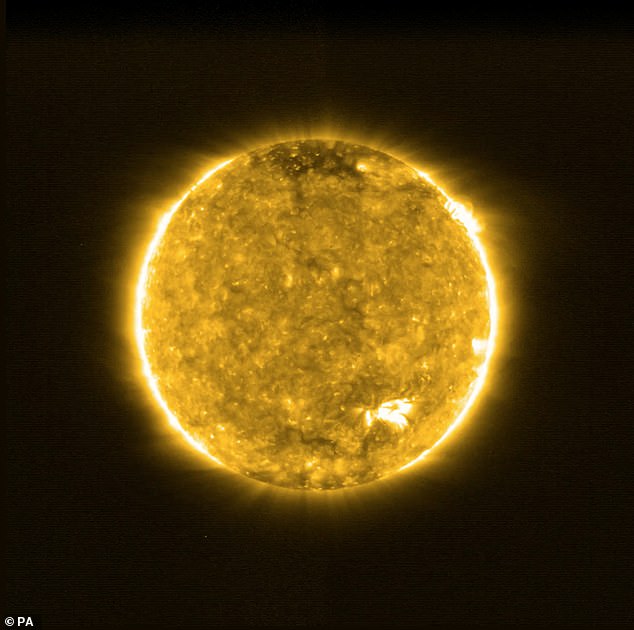The Sun’s corona — the outermost layer which can reach temperatures in excess of one million degrees Celsius — is chemically very different to the rest of the star despite being physically connected.
Astronomers have been unable to explain, and prove, this phenomenon for more than half a century, making it one of astronomy’s enduring conundrums.
Now, researchers have found the first observational evidence showing magnetic waves in the chromosphere — the Sun’s middle layer — split up plasma, forcing only charged ions into the corona and leaving behind neutral particles.
A paper published today from astronomers at University College London and the Italian Space Agency provide the first ever proof to back up this long-held theory.
Researchers have found the first observational evidence showing magnetic waves in the chromosphere — the Sun’s middle layer — split up plasma, forcing only charged ions into the corona and leaving behind neutral particles
Researchers analysed data from telescopes in New Mexico as well as in space to simultaneously observe the same part of the Sun in a bid to find the waves.
The observed patterns were recreated using computer modelling and scientists found waves reflecting in the chromosphere were magnetically linked to areas of abundant ionised particles in the corona.
‘These results indicate a connection between sunspot chromospheric activity and observable changes in coronal plasma composition,’ the researchers write in their study, published today in Philosophical Transactions of the Royal Society.
The theory of magnetic waves splitting up plasma and forcing ions to the corona was first postulated in 1942.
What causes the waves remains unknown, but scientists believe they are generated in the volatile corona by millions of mini explosions, known as nanoflares.
Dr Deborah Baker, lead author of the study, told MailOnline: ‘The different chemical compositions of the Sun’s inner and outer layers were first noted more than 50 years ago.
‘This discovery generated what is one of the long-standing open questions in astrophysics.
‘The difference in composition is surprising, given that the layers are physically linked, and that matter in the corona originates in the innermost layer, the photosphere.
‘Now, thanks to a unique combination of ground-based and space-based observations of the solar atmosphere, carried out nearly simultaneously, it has been possible to definitively detect magnetic waves in the chromosphere and link these to an abundance of elements in the corona that are not found in the inner regions of the Sun.’
Dr Marco Stangalini from the Italian Space Agency in Rome says the findings stand true for other stars as well as the Sun.
‘By observing our local laboratory, the Sun, we can improve understanding of the Universe far beyond it,’ he says.

The theory of magnetic waves splitting up plasma and forcing ions to the corona was first postulated in 1942. What causes the waves remains unknown, but scientists believe they are generated in the volatile corona by millions of mini explosions, known as nanoflares. Pictured, the surface of the Sun
Astronomers are more interested now in the Sun’s corona than ever before because of its role in creating the solar wind.
It is the solar wind, which carries ions 92 million miles from the Sun to the Earth, that creates the Northern and Southern lights.
As these charged particles reach Earth’s magnetic field, which is most powerful at the poles, they release energy and this manifests as the mesmerising celestial light show we see on Earth, visible at high and low latitudes.
However, when the steady stream of charged particles turns into a deluge following a violent belch from the surface of the Sun, this can impact on delicate electrical systems and satellite-dependent industries.
‘Identifying the processes that shape the corona is crucial as we attempt to better understand the solar wind, a stream of charged particles flowing outward from the Sun, which can disrupt and damage satellites and infrastructure on Earth,’ says Dr Baker.
‘Our new findings will help us to analyse the solar wind and trace it back to where it is coming from in the Sun’s atmosphere.’
